FREE Standard Shipping On All Orders $100 or More!*
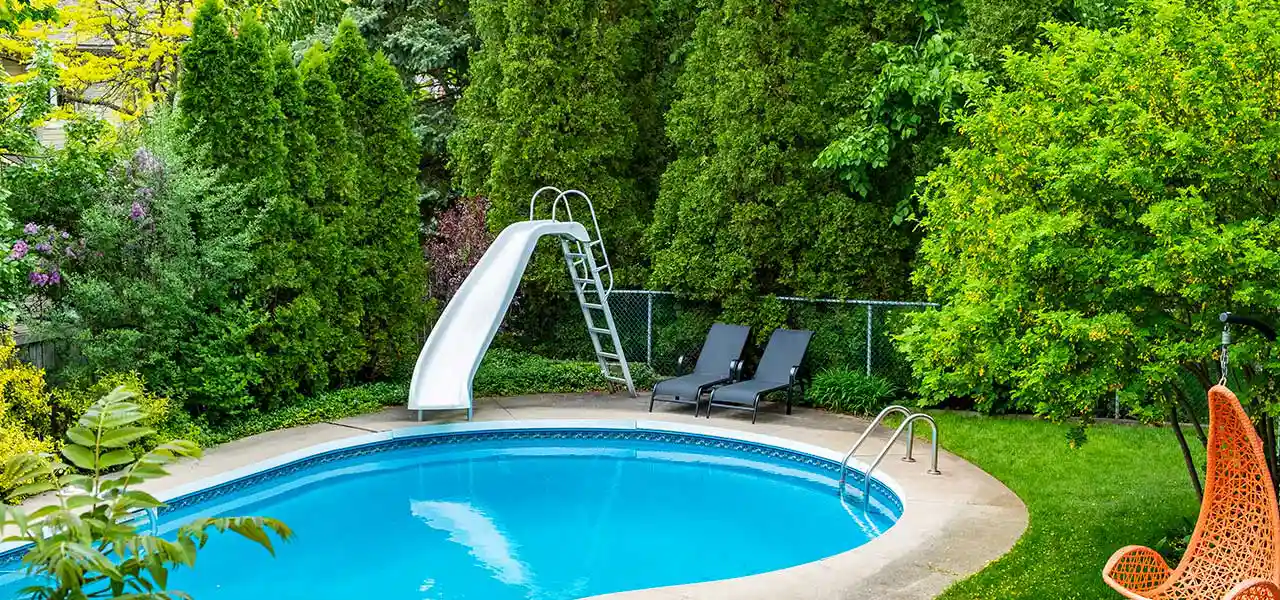
Best & Worst Trees to Plant Around a Pool
Great landscaping around a swimming pool can really make your pool pop. That said, plants and trees need to be chosen carefully. Trees with lots of leaf litter, excessive pollen, berries, or budding debris can cause a lot of extra work for you and your pool filter.
Furthermore, trees with extensive root systems can damage pool walls or pool plumbing. And cute little trees that grow into huge monsters can block the sun's warmth, or may even block the sight and sounds of the pool, which can be unsafe.
Many pool guys will say "the best trees for a pool are no trees at all." But this is not always realistic, nor is it desirable in most cases. So what are the best trees to plant around a pool? Which trees are the worst for pool maintenance? Let's take a look and find out!
Landscaping Considerations
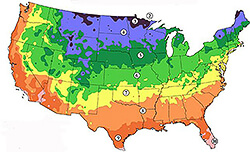
Climate:
Pools located in more temperate hardiness zones (southern states) have a wider variety of trees that can flourish around the pool. Northern pools can still use many tropicals if planted in large pots, or cut back during fall and mulched over.
Shade:
If you are specifically looking for shade around the pool or in a certain area of your yard, that can help guide your tree choice. Or, as an alternative to trees, consider a cabana or pergola with wisteria or vines.
Privacy:
Are you trying to block out the neighbors' prying eyes, extra noise, or a less than perfect view? Fast growing evergreens may be a good choice for one or two sides of the pool.
Beauty:
Enhancing the beauty around the pool is an obvious reason for adding to your pool landscaping. Flowering trees, fruit trees, and deciduous trees (those that shed leaves during fall) may be pretty, but can be quite messy.
Excellent Tree Choices
The best trees to plant around a pool include: acacia, banana, citrus, evergreens (arbor vitae, cypress, spruce), holly and magnolia (also evergreen), olive trees (non fruit bearing), oleander* (actually a large bush), and windmill palms (hardy in the southern states, all the way up to zone 6).
*IMPORTANT! Though popular as an ornamental landscaping bush, homeowners with pets or young children should avoid planting oleander. This is because oleander plants produce high levels of toxins. As little as a single leaf can kill if ingested.
Other "Good Seeds"
Daylilies and Sedums: Visually pleasing, but still low maintenance.
Ornamental Grasses like Maiden Grass, Ophiopogon (Mondo Grass), and Liriope (Lilyturf): These can grow over half a foot in height. They can be used around an inground pool or near the base of an above ground pool.
Calycanthus, a.k.a. Sweet Shrubs: These can add pleasant aromas to the yard, much like citrus trees and oleander can.
Harbour Dwarf Nandina and Dwarf Yaupon Holly: Both are great small shrubs to line the border of a walking path or the perimeter of the pool decking. They're low maintenance and very resilient.
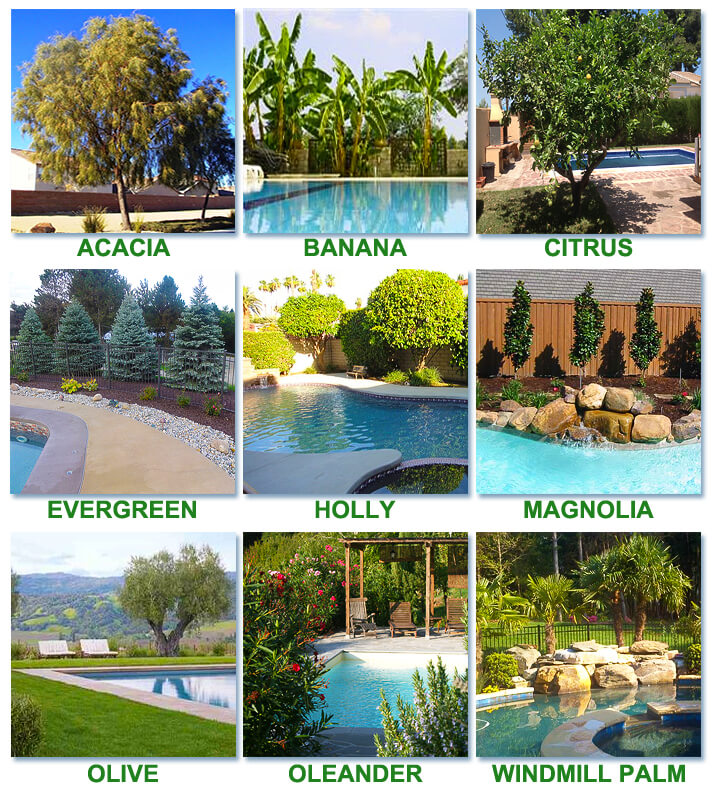
Worst Trees to Plant Around a Pool
Just as there are trees that do well around pools, there are lots of trees that won't. In most cases, chlorinated water or salt pool splash-out is not much of a concern, as long as trees around a pool are regularly watered.
Landscaping Considerations
Climate: Again the regional climate is the number one consideration when choosing your trees. Refer to the map above and look for trees that are "hardy" in your local zones. A tree that does well in zone 8 may not survive winters in zone 7.
Litter: Some trees constantly shed buds, flowers, leaves, and bark. With a little wind, this can quickly fill your pool with debris. Using a leaf catcher or even a solar cover can mitigate some of this issue. Deciduous trees are not necessarily bad, but will give the backyard a bare appearance during winter.
Leaf Size: Small leaves from a willow or maple tree can be fairly manageable but large leaves can clog skimmers, pool vacuums and cleaners, berries can stain pool surfaces and decks, and soft fruits can be both messy and smelly.
Root Systems: Most trees grow root systems of about the same size as the tree branch systems. Some trees have very aggressive roots that can damage pool walls or vinyl liners when planted too close to inground pools. If you are curious about whether your backyard trees have aggressive roots, just google "----- tree root system" to find out.
Poor Tree Choices
The worst trees to plant around a pool include (among others):
Mulberries, Cottonwoods, Aspens, Willows, Silver Maple, and American Elm Trees: These trees have extensive and invasive root systems that will seek moisture at any cost. If close enough, these trees can erode the ground around your swimming pool, and will seek and destroy underground plumbing.
Palm Trees, Fruit Trees, Grape Vines, Berry Plants, Nut Trees, and Flowering Trees: Any tree or plant that falls within this category will lead to excessive cleaning and possible staining. Insects and rodents will also be attracted to these choices.
Needle Bearing Evergreen Trees, Large Deciduous Trees, and Crape Myrtles: Larger leaves that end up in the swimming pool can complicate vacuuming and will put extra stress on the pool equipment. Finer needles that drop are known to sneak by the skimmer baskets and clog up your pool pump impeller.
Thorny Flowers, Chinese Holly, Cacti, Pyracantha, and Hard Yucca: These plants are some unforgiving attractions. Most pool users will want to avoid brushing up against any of those mentioned without a shirt protecting your back. As long as they're kept away from frequent pathways around the pool, you may still be able to use these to accent your backyard landscape.
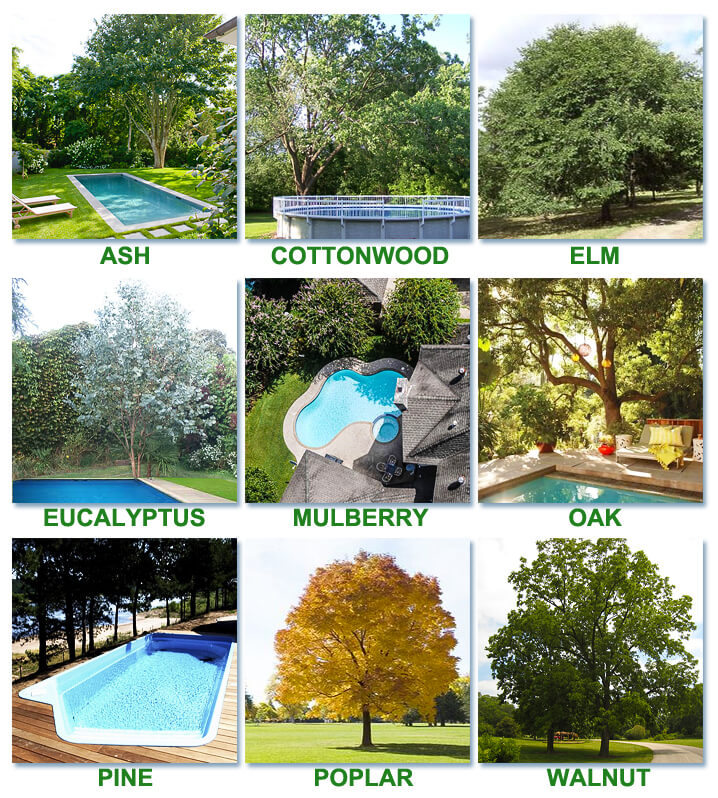
Landscaping Control Tips for Pool Owners
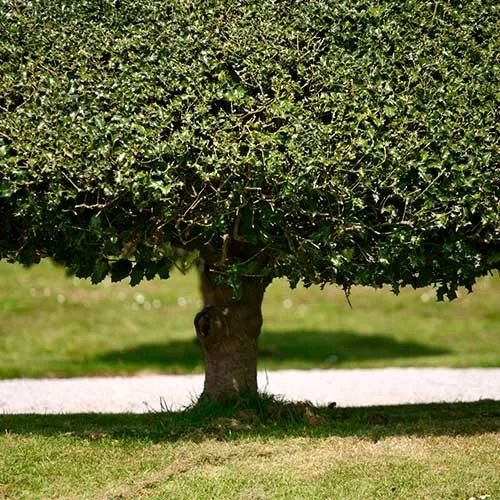
Let me finish by saying this – I love trees. If they were there before the pool, that doesn't necessarily mean that you have to remove them once the pool is installed. Regular maintenance and trimming will help keep any potential issues in check. And, as we mentioned earlier, a leaf catcher net or solar cover can do wonders for managing debris loads. Make sure to invest in a good leaf rake, and consider purchasing a leaf canister for your vacuum or suction side pool cleaner to keep heavy leaf debris from clogging up the skimmer and pump baskets. For extremely leafy pools, a pressure side or robotic cleaner may be the best choice for an automatic pool cleaner. You can also use something like a leaf gulper for quick debris cleanup.
Most tree roots spread out as far as their branches, but some types of thirsty trees will extend well beyond that. I swear that some trees can "smell" the water in the pool, and make a beeline for it, stretching their roots out until they poke a hole in the liner or bust up the floor and walls of your pool. Do yourself a favor, here. Find some nice small plants or bushes to put around your pool and leave the trees to the other parts of your yard.
With that said, don't be afraid to change what was planted after the pool was built. If you have trees around a pool that have become undesirable tenants, you can always start over with something new!